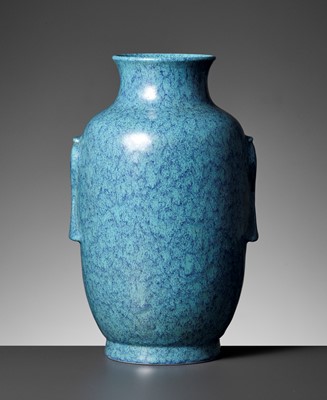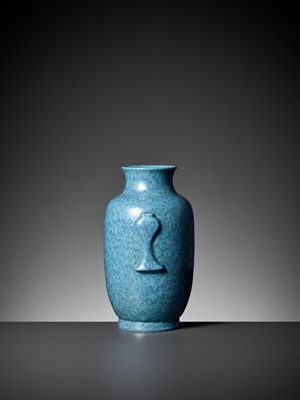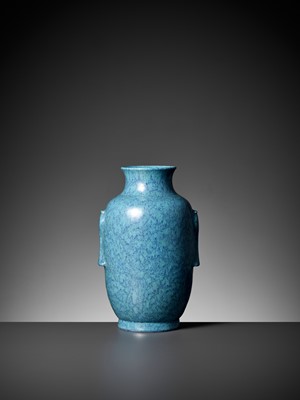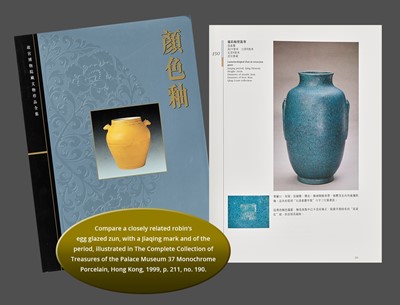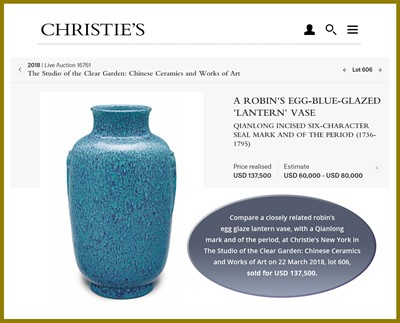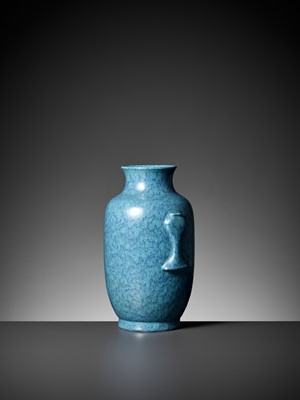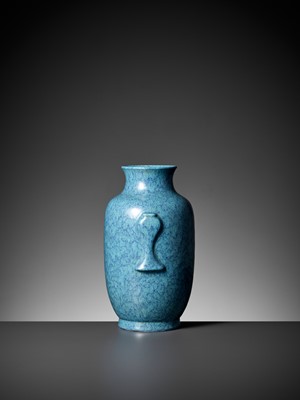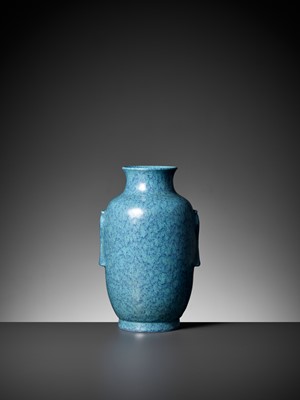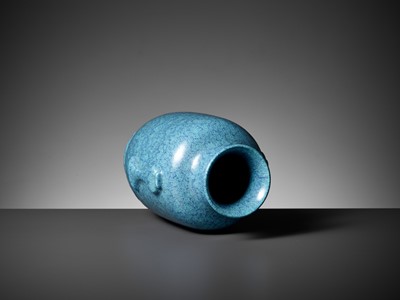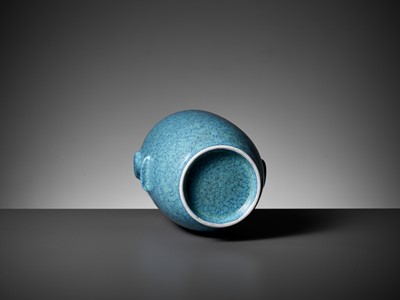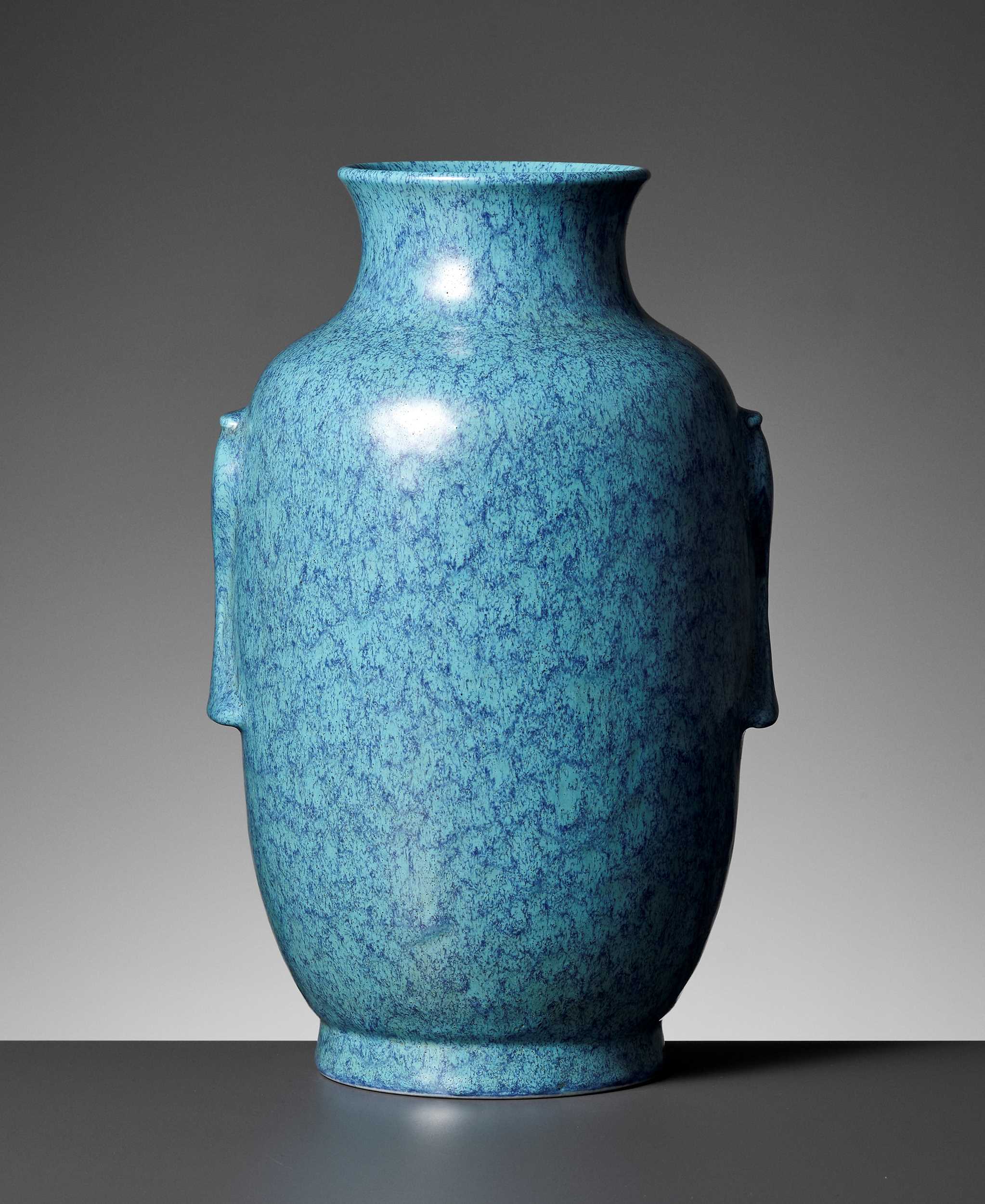11th Mar, 2022 10:00
DAY 2 - TWO-DAY AUCTION - Fine Chinese Art / 中國藝術集珍 / Buddhism & Hinduism
511
A ROBIN’S EGG GLAZED ‘LANTERN’ VASE, ZUN, QIANLONG TO JIAQING PERIOD
乾隆至嘉慶時期爐鈞釉燈籠紋尊
Sold for €9,480
including Buyer's Premium
China, 1736-1820. The body tapers slightly towards the foot and is flanked by a pair of prominently molded handles in the shape of inverted vases below the high shoulder and slightly waisted neck. The vase is covered overall with an opaque turquoise glaze densely mottled in bright and dark blue that also covers the recessed base entirely.
Provenance: From a private collection in Hampshire, United Kingdom, by repute acquired in the 1960s.
Condition: Excellent condition with minor wear and minimal firing irregularities.
Weight: 1,097 g
Dimensions: Height 22.5 cm
Vases of this lantern shape, all applied with unusual mock handles of inverted vase shape, originated in the Yongzheng period, when they were made with Guan and Ge-type glazes, such as the two Yongzheng examples in the Palace Museum, Beijing, illustrated by Geng Baochang (ed.), Gugong Bowuyuan cang Qingdai yuyao ciqi (Porcelains from the Qing dynasty Imperial kilns in the Palace Museum collection), Beijing, 2005, pls. 174 and 206. However, during the Qianlong period, the shape became more popular as a vehicle for the robin's egg-blue glaze.
The ‘Robin’s egg’ glaze represents a significant technical innovation of the Yongzheng period (1723-35) attributable to Tang Ying (1682-1756), the greatest porcelain superintendent in Chinese history. The Yongzheng Emperor, who initiated many revivals of earlier ceramic techniques, was particularly enamored with the variegated Jun glazes of the Song (960-1279) and Ming (1368-1644) dynasties. In order to have the glazes recreated or imitated, Tang Ying sent his trusted assistant from the imperial kilns in Jingdezhen, Jiangxi province, on study trips to the Jun region in Henan province to learn from the local potters and even went as far as having ceramic raw materials mined in the Jun area transported over thousands of kilometers to Jingdezhen. Among the many types of glazes derived from those efforts are mottled purple ones such as the flambé variety, and mottled turquoise ones such as ‘robin’s egg’, which Tang Ying termed lu Jun or Oven Jun, i.e., a Jun glaze fired in low-temperature ovens instead of high-temperature kilns (see Jingdezhen Institute of Ceramic Archaeology et al, The Cultures of Porcelain Superintendents and Jingdezhen, conference volume, Nanchang, 2011). The ‘robin’s egg’ glaze is mentioned on a stele in Jingdezhen, inscribed by Tang Ying, as one of the major types of ceramics that he succeeded in firing and proposed as suitable for regular delivery to the Imperial court. Its color is described as intermediate between the glazes of the Shiwan kilns of Foshan, Guangdong, and those used by the Yixing kilns in Jiangsu for their zisha tea pots, but having a better and more beautiful flow.
According to scientific research conducted by the Victoria & Albert Museum and Oxford University, ‘robin’s egg’ glazes are high-lead, low-temperature enamel-type compositions fired in oxidation and are colored largely with copper and opacified with lead arsenate to achieve their extraordinary beautiful effect. See Nigel Wood, Rose Kerr et al, ‘An evaluation of the composition and production processes of Chinese “robin’s egg” glazes’, International Symposium on Ancient Ceramics, Shanghai, 2002, pp. 337-353.
Literature comparison: Compare a closely related robin’s egg glazed zun, with a Jiaqing mark and of the period, illustrated in The Complete Collection of Treasures of the Palace Museum 37 Monochrome Porcelain, Hong Kong, 1999, p. 211, no. 190.
Auction result comparison: Compare a closely related robin’s egg glaze lantern vase, with a Qianlong mark and of the period, at Christie’s New York in The Studio of the Clear Garden: Chinese Ceramics and Works of Art on 22 March 2018, lot 606, sold for USD 137,500.
乾隆至嘉慶時期爐鈞釉燈籠紋尊
中國,1736-1820年。釉質呈藍綠小片斑狀,腹部兩側對稱燈籠紋浮雕,圈足。
來源:英國漢普郡私人收藏,據説購於上世紀六十年代。
品相:狀況極佳,輕微磨損,輕微燒製瑕疵。
重量:1,097 克
尺寸:高 22.5 厘米
拍賣結果比較:比較一件相近爐鈞釉燈籠紋尊,乾隆款及年代,見紐約佳士得The Studio of the Clear Garden: Chinese Ceramics and Works of Art 2018年3月22日 lot 606, 售價USD 137,500。
China, 1736-1820. The body tapers slightly towards the foot and is flanked by a pair of prominently molded handles in the shape of inverted vases below the high shoulder and slightly waisted neck. The vase is covered overall with an opaque turquoise glaze densely mottled in bright and dark blue that also covers the recessed base entirely.
Provenance: From a private collection in Hampshire, United Kingdom, by repute acquired in the 1960s.
Condition: Excellent condition with minor wear and minimal firing irregularities.
Weight: 1,097 g
Dimensions: Height 22.5 cm
Vases of this lantern shape, all applied with unusual mock handles of inverted vase shape, originated in the Yongzheng period, when they were made with Guan and Ge-type glazes, such as the two Yongzheng examples in the Palace Museum, Beijing, illustrated by Geng Baochang (ed.), Gugong Bowuyuan cang Qingdai yuyao ciqi (Porcelains from the Qing dynasty Imperial kilns in the Palace Museum collection), Beijing, 2005, pls. 174 and 206. However, during the Qianlong period, the shape became more popular as a vehicle for the robin's egg-blue glaze.
The ‘Robin’s egg’ glaze represents a significant technical innovation of the Yongzheng period (1723-35) attributable to Tang Ying (1682-1756), the greatest porcelain superintendent in Chinese history. The Yongzheng Emperor, who initiated many revivals of earlier ceramic techniques, was particularly enamored with the variegated Jun glazes of the Song (960-1279) and Ming (1368-1644) dynasties. In order to have the glazes recreated or imitated, Tang Ying sent his trusted assistant from the imperial kilns in Jingdezhen, Jiangxi province, on study trips to the Jun region in Henan province to learn from the local potters and even went as far as having ceramic raw materials mined in the Jun area transported over thousands of kilometers to Jingdezhen. Among the many types of glazes derived from those efforts are mottled purple ones such as the flambé variety, and mottled turquoise ones such as ‘robin’s egg’, which Tang Ying termed lu Jun or Oven Jun, i.e., a Jun glaze fired in low-temperature ovens instead of high-temperature kilns (see Jingdezhen Institute of Ceramic Archaeology et al, The Cultures of Porcelain Superintendents and Jingdezhen, conference volume, Nanchang, 2011). The ‘robin’s egg’ glaze is mentioned on a stele in Jingdezhen, inscribed by Tang Ying, as one of the major types of ceramics that he succeeded in firing and proposed as suitable for regular delivery to the Imperial court. Its color is described as intermediate between the glazes of the Shiwan kilns of Foshan, Guangdong, and those used by the Yixing kilns in Jiangsu for their zisha tea pots, but having a better and more beautiful flow.
According to scientific research conducted by the Victoria & Albert Museum and Oxford University, ‘robin’s egg’ glazes are high-lead, low-temperature enamel-type compositions fired in oxidation and are colored largely with copper and opacified with lead arsenate to achieve their extraordinary beautiful effect. See Nigel Wood, Rose Kerr et al, ‘An evaluation of the composition and production processes of Chinese “robin’s egg” glazes’, International Symposium on Ancient Ceramics, Shanghai, 2002, pp. 337-353.
Literature comparison: Compare a closely related robin’s egg glazed zun, with a Jiaqing mark and of the period, illustrated in The Complete Collection of Treasures of the Palace Museum 37 Monochrome Porcelain, Hong Kong, 1999, p. 211, no. 190.
Auction result comparison: Compare a closely related robin’s egg glaze lantern vase, with a Qianlong mark and of the period, at Christie’s New York in The Studio of the Clear Garden: Chinese Ceramics and Works of Art on 22 March 2018, lot 606, sold for USD 137,500.
乾隆至嘉慶時期爐鈞釉燈籠紋尊
中國,1736-1820年。釉質呈藍綠小片斑狀,腹部兩側對稱燈籠紋浮雕,圈足。
來源:英國漢普郡私人收藏,據説購於上世紀六十年代。
品相:狀況極佳,輕微磨損,輕微燒製瑕疵。
重量:1,097 克
尺寸:高 22.5 厘米
拍賣結果比較:比較一件相近爐鈞釉燈籠紋尊,乾隆款及年代,見紐約佳士得The Studio of the Clear Garden: Chinese Ceramics and Works of Art 2018年3月22日 lot 606, 售價USD 137,500。
Zacke Live Online Bidding
Our online bidding platform makes it easier than ever to bid in our auctions! When you bid through our website, you can take advantage of our premium buyer's terms without incurring any additional online bidding surcharges.
To bid live online, you'll need to create an online account. Once your account is created and your identity is verified, you can register to bid in an auction up to 12 hours before the auction begins.
Intended Spend and Bid Limits
When you register to bid in an online auction, you will need to share your intended maximum spending budget for the auction. We will then review your intended spend and set a bid limit for you. Once you have pre-registered for a live online auction, you can see your intended spend and bid limit by going to 'Account Settings' and clicking on 'Live Bidding Registrations'.
Your bid limit will be the maximum amount you can bid during the auction. Your bid limit is for the hammer price and is not affected by the buyer’s premium and VAT. For example, if you have a bid limit of €1,000 and place two winning bids for €300 and €200, then you will only be able to bid €500 for the rest of the auction. If you try to place a bid that is higher than €500, you will not be able to do so.
Online Absentee and Telephone Bids
You can now leave absentee and telephone bids on our website!
Absentee Bidding
Once you've created an account and your identity is verified, you can leave your absentee bid directly on the lot page. We will contact you when your bids have been confirmed.
Telephone Bidding
Once you've created an account and your identity is verified, you can leave telephone bids online. We will contact you when your bids have been confirmed.
Classic Absentee and Telephone Bidding Form
You can still submit absentee and telephone bids by email or fax if you prefer. Simply fill out the Absentee Bidding/Telephone bidding form and return it to us by email at office@zacke.at or by fax at +43 (1) 532 04 52 20. You can download the PDF from our Upcoming Auctions page.
How-To Guides
How to Create Your Personal Zacke Account
How to Register to Bid on Zacke Live
How to Leave Absentee Bids Online
How to Leave Telephone Bids Online
中文版本的操作指南
创建新账号
注册Zacke Live在线直播竞拍(免平台费)
缺席投标和电话投标
Third-Party Bidding
We partner with best-in-class third-party partners to make it easy for you to bid online in the channel of your choice. Please note that if you bid with one of our third-party online partners, then there will be a live bidding surcharge on top of your final purchase price. You can find all of our fees here. Here's a full list of our third-party partners:
- 51 Bid Live
- EpaiLive
- ArtFoxLive
- Invaluable
- LiveAuctioneers
- the-saleroom
- lot-tissimo
- Drouot
Please note that we place different auctions on different platforms. For example, in general, we only place Chinese art auctions on 51 Bid Live.
Bidding in Person
You must register to bid in person and will be assigned a paddle at the auction. Please contact us at office@zacke.at or +43 (1) 532 04 52 for the latest local health and safety guidelines.
